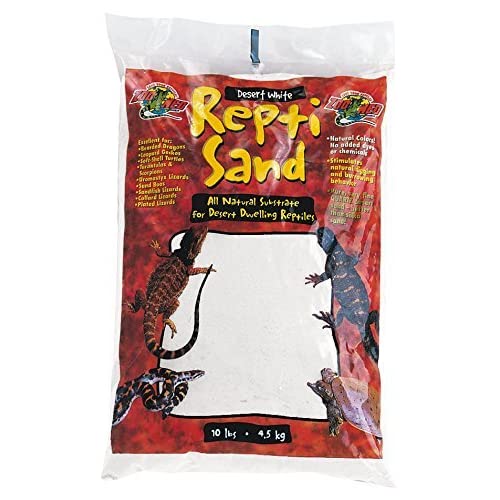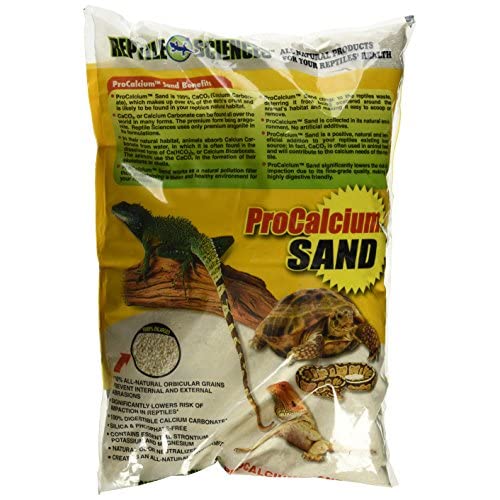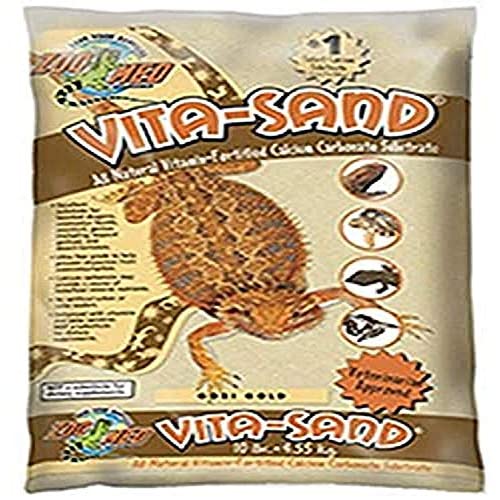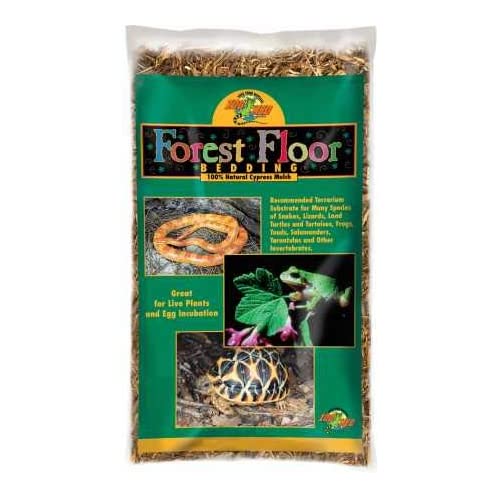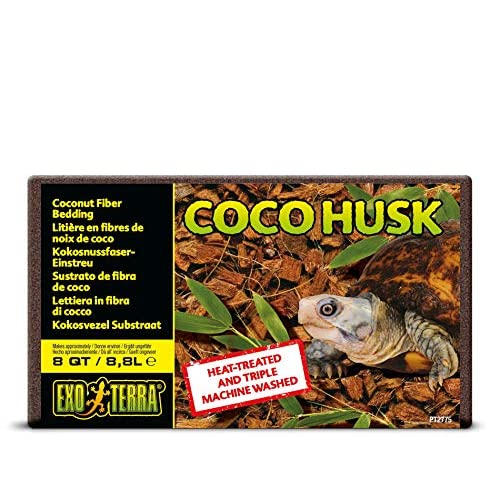Bearded dragon is one of the oldest and most popular reptiles, many people choose to be their pets. Besides bearded dragons are also easy pets, and they are quite docile, you do not need to put too much effort to take care of it like some other pets.
But you also have to provide a bearded dragon with a complete living environment so that it can develop in the best way. In particular, the substrate is an indispensable element in the habitat of the bearded dragon.
There are many substrate options but the best loose substrate for bearded dragons is the most popular. So today we will show you how to choose a good substrate. And along with that is the list of the best loose substrate for bearded dragons review 2021.

Is loose substrate good or bad for bearded dragon?
Loose substrate may be a popular choice but it is NOT recommended for bearded dragons. It can hurt the reptile’s eyes and nose when it sticks to it and the reptile cannot take it out.
It is also unsafe when your bearded dragon eats substrate. This is a natural behavior when reptiles self-supply minerals and calcium from the substrate.
But you can also consider some slightly safer substrates when you still want to use loose substrates. We have considered a lot and gathered some of the safest products.
What are the common types of bearded dragon loose substrates?
Loose substrates for bearded dragons are often a common choice for owners because they have good wicking capabilities. Not only that, but a soft texture will also bring a bearded dragon the most comfortable and smooth operation.
Currently, on the market there are many types of loose substrates so that you may feel lost in the information. Each type has its own advantages and disadvantages, creating a variety and abundance of products.
Let’s take a look at some of the most popular loose substrates currently on the market. We will also give you the best substrate for bearded dragons of each type.
#1 Sand
Bearded dragon’s habitat is largely related to sand. For that reason, it can be said that sand is the most popular choice. You can easily see that sand is always the top result when people search for the best loose substrates for bearded dragons.
However sand has many types and not all are ideal for bearded dragons. Nor can you use any sand you find around your home as a bearded dragon substrate.
Remember that beach sand or construction sand should never be used as a substrate for bearded dragons. These types of sand often have sharp particles, which can cause bearded dragon damage. Once a bearded dragon eats sand, it can lead to dangerous situations.
Some common types of sand used by many people today are:
#Reptisand
Reptisand is often referred to as silicon sand and is widely used for its smooth and striking texture. It consists of small and fine quartz particles, which do not clump and absorb well.
Reptisand often has striking colors, some use dyes and some are natural colors. This sand is very suitable for desert setups for bearded dragons habitat.
The best reptisand product on the market we can look for is Zoo Med ReptiSand. This is a natural white desert sand, completely free of any chemicals or detergents. This product is ideal for recreating the natural habitat for bearded dragons.
This substrate is considered one of the best sand bearded dragon substrates because it provides a smooth environment, stimulating the ability to burrow naturally for pets. It is also ideal for egg-laying bearded dragons because of this softness.
Other reptiles may also use this substrate. The product can conduct heat well and absorb well so that it can handle waste as well as odors in the living environment. You can clean these substrates easily by screening them.
However, it is often quite dusty, affecting the eyes, nose as well as the habitat of bearded dragons. And it’s also not really good for digestion of bearded dragons.
#Calcium sand
Calcium sand is also a popular choice when owners want to find a good base for the bearded dragons’ digestive system. In fact, calcium sand is not real sand but it is calcium carbonate.
In theory, when a bearded dragon ate calcium sand it meant that it was consuming more calcium. And people believe that calcium is better for the bearded dragons’ digestive system than real sand.
Whether or not this is true is a substrate that provides exceptional appearance and comfort for bearded dragons.
Reptile Sciences Terrarium Sand is a substrate considered to be the best sand for bearded dragons. You can easily find this product at any pet store or on e-commerce sites.
This type of substrate contains natural minerals and is necessary for bearded dragons. It can also reduce odors and has good absorbency.
However, you should note that this product should not be used for baby bearded dragons because it may negatively affect their health. Too much calcium will affect the acidity in their stomachs.
#Vita sand
Vita sand is also a popular option besides calcium sand. These two types of sand are quite similar, both carry essential minerals but vita sand is a little different. Vita sand includes beta Cantone, which does not cause bad effects on bearded dragons if they are used too much.
Zoo Med Vita-Sand is a good choice when you are looking for a vita sand product for your pet. This is a good option for resolving bowel problems for bearded dragons.
This product also has a smooth texture, does not hurt the skin of bearded dragons. It contains no dyes or chemicals and is completely natural. If you do not like white, you can choose other colors instead.
This sand is also easier to back up and safer than normal sand many times. To properly use bearded dragons, you should also avoid putting food directly on the sand. Instead, place the food in a dish of medium height and width to avoid spillage.
However, this product is also quite dusty so that you should pay attention every time you pour sand into the cage of bearded dragons. You should also pay close attention if bearded dragons are damaged by dust.
#2 Walnut shells
Walnut shell is also one of the other popular options. This type of substrate is made from crushed natural walnut shells, does not contain chemicals so many people use it.
This substrate also has good absorbency, eliminates odor as well as creates comfort for bearded dragon. Many people also choose walnut shells as a background for bearded dragons because it can recreate the natural habitat for pets.
However, this type of substrate also has disadvantages such as it may affect bearded dragon’s digestive system if swallowed. Walnut shells have a fairly sharp texture so you also have to be careful when using this type of substrate for bearded dragons.
The advantage is that you can use it as a natural fertilizer for plants after removal. And it is also completely environmentally friendly.
#3 Wood chips/ bark
Like walnut shells, wood chips are also the natural substrate used to simulate the most natural habitat for bearded dragons.
As the name implies, wood chips are small pieces of wood that have been carefully processed to become products. This type of substrate is light, durable and extremely absorbent. This is also a budget option because you can use this type of substrate many times (reuse) and each time has an extended duration. It also has the ability to remove odors as well as liquid waste from bearded dragons.
You can refer to Zoo Med Forest Floor Bedding, this is one of the most appreciated substrates on the market today. This product is a natural cypress coating, undergoing careful handling to remove sharp fragments. It is completely natural and does not contain any artificiality.
This is the ideal substrate for you to simulate the natural rainforest environment for bearded dragons, and it has good moisture retention. For bearded dragons who prefer wet environments, this is the perfect substrate.
However, you still have to pay attention because the bearded dragon may eat these chips. Not good for the gut of bearded dragons.
#4 Coconut fiber/ husk
Coconut fiber (also called eco earth for bearded dragons) is the perfect substrate to keep and moisturize. It has good water absorption capacity and is excellent for removing waste immediately. This substrate keeps the moisture in bearded dragon tanks always stable and maintains an ideal humidity.
Coir is also completely natural so it is not only environmentally friendly but also guaranteed not to harm bearded dragons. It is also the perfect substrate to simulate the wet rainforest for bearded dragon habitat.
Coconut fiber can be reused after you dry it, but it is not highly recommended. You can use it as a bio-fertilizer after use.
One product that you should include in your consideration list is Exo Terra Coco Husk. This type of substrate is suitable for any bearded dragons of any size and age.
This product has the ability to stimulate the digging ability of bearded dragons. This action is the natural and necessary behavior of each bearded dragon. A natural and well-textured substrate like this product will be needed for a bearded dragon.
But the weakness of this product is that it is easy to rot if kept in high humidity for a long time. As such, its life span will decrease and it is easy to produce harmful bacteria. So you should not maintain too high humidity as well as make this substrate wet for a long time.
How to choose the best loose substrate for bearded dragons?
Choosing the best loose substrate for a bearded dragon is not a simple task. It requires you to grasp the bearded dragon lifestyle as well as the characteristics of the substrate types.
Currently, there are many competing products on the market with attractive offers, but you must be alert to make the smartest choice. There is a lot of controversy surrounding the issue of the loose substrate being a good choice for bearded dragons? But this is still a popular choice after all.
In order to choose the best product, you should consider a number of factors before making a decision. Some of those factors are:
#1 Friendly
The friendliness here is expressed in two elements: Environmentally friendly material and bearded dragons.
Simply put, you should choose 100% natural substrates, which do not contain chemicals or coloring. This is directly related to bearded dragons’ health as chemicals can affect the bearded dragon’s skin or digestive system. Related to environmental issues because you have to constantly change the substrate.
These natural substrates will also help you simulate the most natural habitat for bearded dragons.
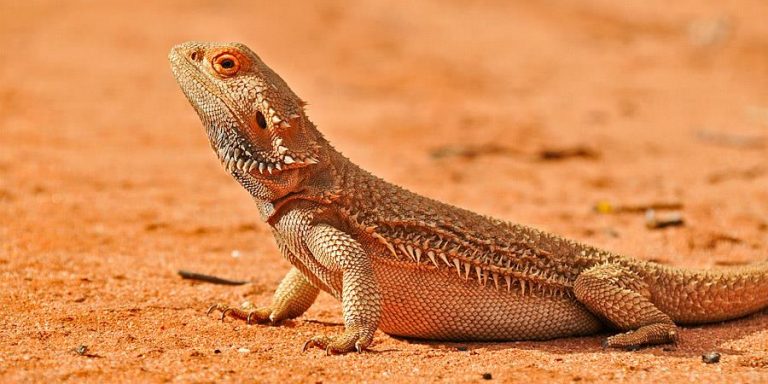
#2 Shape and size
The shape is also a factor that you should consider before choosing any substrate for a bearded dragon. The shape directly affects bearded dragon because it can cause bearded dragon pain or adversely affect the intestines.
You should never choose a texture that has a sharp texture as it can have a negative effect on bearded dragons. It can scratch the skin, hurting open parts such as the bearded dragon’s eyes and nose upon contact.
You should also pay attention to the size because bearded dragons will most likely eat the substrate. This is a natural act to supplement the bearded dragon’s calcium and minerals. Medium-sized substrates are never a good choice as they can cause bearded dragons to chock.
#3 Ease of cleaning
This is one of the factors that you should never overlook before deciding on a substrate type. You should especially clean the habitats regularly, especially the bearded dragons substrate.
If not cleaned regularly, the substrate will produce pathogenic bacteria and mold caused by waste and high humidity. It is a direct source of disease and causes certain injuries to bearded dragons.
If you don’t have a lot of cleaning time, you can use reusable substrates. One advantage of loose substrates is that you can clean them easily by screening, so choose those sizes that are the right size for this cleaning method.
Conclusion
Although loose substrate is controversial because it affects the intestinal tract of bearded dragons, it still has certain advantages. Besides providing bearded dragon a soft bedding, simulating a natural living space, it also helps bearded dragon be dug every day.
Before deciding to buy any type of loose substrate for bearded dragons, you should consider and research carefully. You can also consult experienced people to choose the best loose substrate for bearded dragons.
